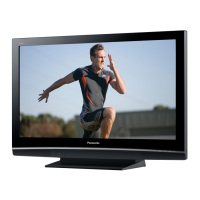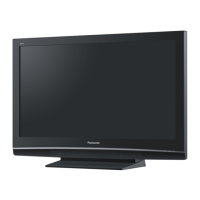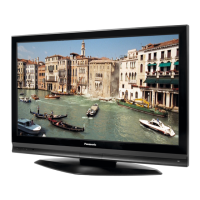Do you have a question about the Panasonic Viera TH-42PX80B and is the answer not in the manual?
Explains the UK's digital switchover process and its implications for TV reception.
Guidelines for safe handling, earthing, and using the mains plug and lead.
Warnings against heat, sunlight, unstable surfaces, and transport hazards.
Notes on image retention, ventilation, and keeping equipment away from the TV.
Instructions for cleaning the display panel, cabinet, and mains plug.
Lists included and optional accessories like remote, cables, and brackets.
Step-by-step guide and cautions for inserting batteries into the remote control.
Warnings and cautions for safe assembly and use of the TV pedestal.
Instructions for assembling the pedestal and securely attaching it to the TV.
Identification of rear TV terminals and instructions for cable management.
Locating and understanding the functions of front panel buttons, LEDs, and sensors.
Detailed explanation of each button on the remote control and its function.
Diagrams and instructions for connecting aerials, DVD recorders, and VCRs.
Steps to power on the TV, initiate auto setup, and configure Owner ID.
Turning on the TV, selecting modes, and choosing programmes using various methods.
How to access and utilize the TV Guide (EPG) and Information banner.
How to automatically turn off the TV after a specified period.
Changing the picture's aspect ratio for optimal screen filling.
Overview of DVB teletext features and how to navigate pages using the remote.
How to view programme listings in landscape or portrait mode and filter lists.
Steps to connect and select input sources for VCR, DVD, and satellite receivers.
How to access and navigate through the TV's various menus and settings.
Detailed configuration options for picture quality and sound modes.
Settings for audio description, speaker distance, NICAM, and HDMI input.
Configuring VIERA Link, Q-Link, Auto Setup, and manual tuning.
Managing Child Lock, Owner ID, System Update, and Power Save settings.
Steps to access DVB-specific setup options like Common Interface and System Update.
Instructions for inserting and accessing CI modules for Pay-TV services.
Steps for downloading and installing new TV software updates.
Creating favourite programme lists and managing DVB/Analogue service lists.
Steps to select, add, rename, move, or delete favourite programmes.
Hiding unwanted DVB services and changing analogue programme names/positions.
Locking specific programmes or inputs and managing the Child Lock PIN.
Initial steps to select the broadcast mode for tuning programmes.
Accessing the Tuning Menu and initiating the Auto Setup process.
Steps for automatic tuning, manual DVB tuning, and manual analogue tuning.
Adding new DVB services and checking DVB signal condition and quality.
Procedure to reset the TV to its original factory condition.
Steps to enter a PIN and personal information for owner identification.
How to label input terminals for easier identification or skip unused ones.
How to select the PC input and configure picture/setup menus for PC display.
Steps to access the Timer Programming menu and set up recordings.
Guide to starting, changing, cancelling, and viewing details of timer programming events.
Steps to insert the SD card, enter Photo View Mode, and navigate thumbnails.
Summary table of features available through Q-Link and VIERA Link connections.
Diagrams and notes on connecting equipment via SCART and HDMI for Link functions.
Preparations for Q-Link, features like Easy playback, and Power on/off links.
Preparations for VIERA Link, features like Easy playback, and power control.
How to record current programmes using a DIGA recorder via VIERA Link.
How to pause live TV and resume playback, with recording to HDD.
Steps to display the VIERA Link Menu and select equipment to control.
Controlling theatre speakers and adjusting volume for connected audio equipment.
Diagrams showing connections for camcorders, game consoles, amplifiers, and DVD players.
Table indicating compatible equipment types for each TV terminal (AV1, AV2, AV3).
How the Auto Aspect feature determines and adjusts the picture aspect ratio.
Information on HDMI connections, compatibility, and signal types.
Steps to check for and download new DVB software versions.
Information on supported photo data formats and SCART/HDMI terminal pin configurations.
Guidelines for connecting a PC, including supported resolutions and scanning frequencies.
Solutions for common issues like noise, no image/sound, and Q-Link/VIERA Link problems.
Troubleshooting steps for recording failures, permanently lit spots, and reduced contrast.
How to fix chaotic images, no display, blurry pictures, and sound issues.
Solutions for DVB interference, unusual HDMI pictures, standby mode, and remote control errors.
Explanations for various on-screen messages and the recommended actions to resolve them.
Definitions of terms used throughout the manual, such as DVB, EPG, and HDMI.
Alphabetical index to quickly locate specific topics and features within the manual.
Key technical specifications of the TV, including power, dimensions, and terminal details.
Contact information for customer care, accessory ordering, and website support.
Explains the UK's digital switchover process and its implications for TV reception.
Guidelines for safe handling, earthing, and using the mains plug and lead.
Warnings against heat, sunlight, unstable surfaces, and transport hazards.
Notes on image retention, ventilation, and keeping equipment away from the TV.
Instructions for cleaning the display panel, cabinet, and mains plug.
Lists included and optional accessories like remote, cables, and brackets.
Step-by-step guide and cautions for inserting batteries into the remote control.
Warnings and cautions for safe assembly and use of the TV pedestal.
Instructions for assembling the pedestal and securely attaching it to the TV.
Identification of rear TV terminals and instructions for cable management.
Locating and understanding the functions of front panel buttons, LEDs, and sensors.
Detailed explanation of each button on the remote control and its function.
Diagrams and instructions for connecting aerials, DVD recorders, and VCRs.
Steps to power on the TV, initiate auto setup, and configure Owner ID.
Turning on the TV, selecting modes, and choosing programmes using various methods.
How to access and utilize the TV Guide (EPG) and Information banner.
How to automatically turn off the TV after a specified period.
Changing the picture's aspect ratio for optimal screen filling.
Overview of DVB teletext features and how to navigate pages using the remote.
How to view programme listings in landscape or portrait mode and filter lists.
Steps to connect and select input sources for VCR, DVD, and satellite receivers.
How to access and navigate through the TV's various menus and settings.
Detailed configuration options for picture quality and sound modes.
Settings for audio description, speaker distance, NICAM, and HDMI input.
Configuring VIERA Link, Q-Link, Auto Setup, and manual tuning.
Managing Child Lock, Owner ID, System Update, and Power Save settings.
Steps to access DVB-specific setup options like Common Interface and System Update.
Instructions for inserting and accessing CI modules for Pay-TV services.
Steps for downloading and installing new TV software updates.
Creating favourite programme lists and managing DVB/Analogue service lists.
Steps to select, add, rename, move, or delete favourite programmes.
Hiding unwanted DVB services and changing analogue programme names/positions.
Locking specific programmes or inputs and managing the Child Lock PIN.
Initial steps to select the broadcast mode for tuning programmes.
Accessing the Tuning Menu and initiating the Auto Setup process.
Steps for automatic tuning, manual DVB tuning, and manual analogue tuning.
Adding new DVB services and checking DVB signal condition and quality.
Procedure to reset the TV to its original factory condition.
Steps to enter a PIN and personal information for owner identification.
How to label input terminals for easier identification or skip unused ones.
How to select the PC input and configure picture/setup menus for PC display.
Steps to access the Timer Programming menu and set up recordings.
Guide to starting, changing, cancelling, and viewing details of timer programming events.
Steps to insert the SD card, enter Photo View Mode, and navigate thumbnails.
Summary table of features available through Q-Link and VIERA Link connections.
Diagrams and notes on connecting equipment via SCART and HDMI for Link functions.
Preparations for Q-Link, features like Easy playback, and Power on/off links.
Preparations for VIERA Link, features like Easy playback, and power control.
How to record current programmes using a DIGA recorder via VIERA Link.
How to pause live TV and resume playback, with recording to HDD.
Steps to display the VIERA Link Menu and select equipment to control.
Controlling theatre speakers and adjusting volume for connected audio equipment.
Diagrams showing connections for camcorders, game consoles, amplifiers, and DVD players.
Table indicating compatible equipment types for each TV terminal (AV1, AV2, AV3).
How the Auto Aspect feature determines and adjusts the picture aspect ratio.
Information on HDMI connections, compatibility, and signal types.
Steps to check for and download new DVB software versions.
Information on supported photo data formats and SCART/HDMI terminal pin configurations.
Guidelines for connecting a PC, including supported resolutions and scanning frequencies.
Solutions for common issues like noise, no image/sound, and Q-Link/VIERA Link problems.
Troubleshooting steps for recording failures, permanently lit spots, and reduced contrast.
How to fix chaotic images, no display, blurry pictures, and sound issues.
Solutions for DVB interference, unusual HDMI pictures, standby mode, and remote control errors.
Explanations for various on-screen messages and the recommended actions to resolve them.
Definitions of terms used throughout the manual, such as DVB, EPG, and HDMI.
Alphabetical index to quickly locate specific topics and features within the manual.
Key technical specifications of the TV, including power, dimensions, and terminal details.
Contact information for customer care, accessory ordering, and website support.











